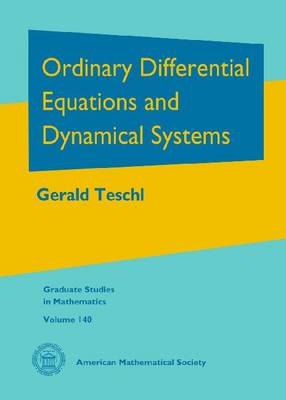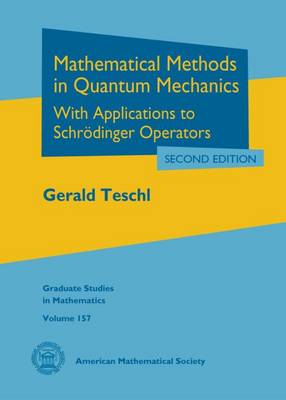Graduate Studies in Mathematics
2 total works
This book provides a self-contained introduction to ordinary differential equations and dynamical systems suitable for beginning graduate students.
The first part begins with some simple examples of explicitly solvable equations and a first glance at qualitative methods. Then the fundamental results concerning the initial value problem are proved: existence, uniqueness, extensibility, dependence on initial conditions. Furthermore, linear equations are considered, including the Floquet theorem, and some perturbation results. As somewhat independent topics, the Frobenius method for linear equations in the complex domain is established and Sturm-Liouville boundary value problems, including oscillation theory, are investigated.
The second part introduces the concept of a dynamical system. The Poincare-Bendixson theorem is proved, and several examples of planar systems from classical mechanics, ecology, and electrical engineering are investigated. Moreover, attractors, Hamiltonian systems, the KAM theorem, and periodic solutions are discussed. Finally, stability is studied, including the stable manifold and the Hartman-Grobman theorem for both continuous and discrete systems.
The third part introduces chaos, beginning with the basics for iterated interval maps and ending with the Smale-Birkhoff theorem and the Melnikov method for homoclinic orbits. The text contains almost three hundred exercises. Additionally, the use of mathematical software systems is incorporated throughout, showing how they can help in the study of differential equations.
The first part begins with some simple examples of explicitly solvable equations and a first glance at qualitative methods. Then the fundamental results concerning the initial value problem are proved: existence, uniqueness, extensibility, dependence on initial conditions. Furthermore, linear equations are considered, including the Floquet theorem, and some perturbation results. As somewhat independent topics, the Frobenius method for linear equations in the complex domain is established and Sturm-Liouville boundary value problems, including oscillation theory, are investigated.
The second part introduces the concept of a dynamical system. The Poincare-Bendixson theorem is proved, and several examples of planar systems from classical mechanics, ecology, and electrical engineering are investigated. Moreover, attractors, Hamiltonian systems, the KAM theorem, and periodic solutions are discussed. Finally, stability is studied, including the stable manifold and the Hartman-Grobman theorem for both continuous and discrete systems.
The third part introduces chaos, beginning with the basics for iterated interval maps and ending with the Smale-Birkhoff theorem and the Melnikov method for homoclinic orbits. The text contains almost three hundred exercises. Additionally, the use of mathematical software systems is incorporated throughout, showing how they can help in the study of differential equations.
Quantum mechanics and the theory of operators on Hilbert space have been deeply linked since their beginnings in the early twentieth century. States of a quantum system correspond to certain elements of the configuration space and observables correspond to certain operators on the space. This book is a brief, but self-contained, introduction to the mathematical methods of quantum mechanics, with a view towards applications to Schroedinger operators.
Part 1 of the book is a concise introduction to the spectral theory of unbounded operators. Only those topics that will be needed for later applications are covered. The spectral theorem is a central topic in this approach and is introduced at an early stage. Part 2 starts with the free Schroedinger equation and computes the free resolvent and time evolution. Position, momentum, and angular momentum are discussed via algebraic methods. Various mathematical methods are developed, which are then used to compute the spectrum of the hydrogen atom. Further topics include the nondegeneracy of the ground state, spectra of atoms, and scattering theory.
This book serves as a self-contained introduction to spectral theory of unbounded operators in Hilbert space with full proofs and minimal prerequisites: Only a solid knowledge of advanced calculus and a one-semester introduction to complex analysis are required. In particular, no functional analysis and no Lebesgue integration theory are assumed. It develops the mathematical tools necessary to prove some key results in nonrelativistic quantum mechanics.
Mathematical Methods in Quantum Mechanics is intended for beginning graduate students in both mathematics and physics and provides a solid foundation for reading more advanced books and current research literature.
This new edition has additions and improvements throughout the book to make the presentation more student friendly.
Part 1 of the book is a concise introduction to the spectral theory of unbounded operators. Only those topics that will be needed for later applications are covered. The spectral theorem is a central topic in this approach and is introduced at an early stage. Part 2 starts with the free Schroedinger equation and computes the free resolvent and time evolution. Position, momentum, and angular momentum are discussed via algebraic methods. Various mathematical methods are developed, which are then used to compute the spectrum of the hydrogen atom. Further topics include the nondegeneracy of the ground state, spectra of atoms, and scattering theory.
This book serves as a self-contained introduction to spectral theory of unbounded operators in Hilbert space with full proofs and minimal prerequisites: Only a solid knowledge of advanced calculus and a one-semester introduction to complex analysis are required. In particular, no functional analysis and no Lebesgue integration theory are assumed. It develops the mathematical tools necessary to prove some key results in nonrelativistic quantum mechanics.
Mathematical Methods in Quantum Mechanics is intended for beginning graduate students in both mathematics and physics and provides a solid foundation for reading more advanced books and current research literature.
This new edition has additions and improvements throughout the book to make the presentation more student friendly.

